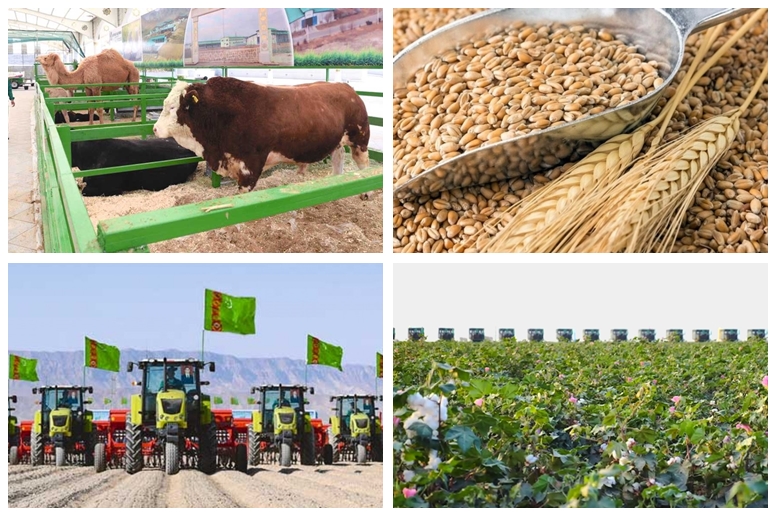The reform of the agricultural sector in Turkmenistan continues as outlined in the “Program of Socio-economic Development of the Country in 2022-2028” and the Program “Revival of a New Era of a Powerful State: The National Program of Socio-economic Development of Turkmenistan in 2022-2052.” 2024 marked another significant step towards strengthening agricultural production, ensuring the domestic market is well-supplied with locally produced crops and livestock products.
Key achievements in Turkmenistan’s agriculture during 2024 include:
- Restructuring of the Ministry of Agriculture: The ministry has been reorganized into five specialized divisions: Turkmengallaönümleri (State Association for Grain Products), Food Industry of Turkmenistan,
- Livestock and Poultry Industry of Turkmenistan, Turkmenobahyzmat (State Association for Agricultural Services), Turkmenpagta (State Concern for Cotton)
- Modernization of Agricultural Machinery: Significant investments have been made in high-performance agricultural machinery, resulting in a substantial fleet of modern equipment, including combine harvesters, cotton harvesters, and other specialized machinery from leading global manufacturers.
- Grain production: In 2024, over 1.4 million tons of grain were harvested from 690,000 hectares of wheat-sown land across the country.
- Scientific research institutes of the Ministry of Agriculture of Turkmenistan have been established.
- The Institute of Grain Growing and Agriculture is located in Arkadag.
- Three new winter wheat varieties were developed in 2024: “Serdar,” “Arkadag,” and “Pyragy.”
- The government implemented significant increases in purchase prices for wheat and cotton starting in 2024. Farmers receive 2,000 manats per ton of wheat. Cotton: medium-fiber cotton: 5,000 manats/ton until 15 October, 4,770 manats/ton until 15 November, and 4,550 manats/ton thereafter. Fine-fiber cotton: 6,700 manats/ton until 15 October, 6,400 manats/ton until 15 November, and 6,100 manats/ton until the end of the harvest season.
- At least 20 legislative acts specifically support agricultural production in Turkmenistan. Key legislation includes: “On Veterinary Medicine” (2014), On Food Safety (new edition), On Plant Protection (2016), “On Grain Production” (2017).
- The Ministry of Agriculture and the State Sanitary and Epidemiological Service of the Ministry of Health and Medical Industry are responsible for ensuring the quality and safety of food products in Turkmenistan.
- Water management: At the end of the year, water treatment plants were opened in Tejen (Akhal province) with a capacity of 30,000 cubic meters of drinking water per day, in the Ak Bugdai district – a sewage treatment plant with a capacity of 15,000 cubic meters per day; in the Murghab district (Mary province) – a water treatment plant with a daily capacity of 25,000 cubic meters.
- Dredgers, as well as earthmoving units from Komatsu and Caterpillar manufacturers, are being purchased for irrigation and collector hydraulic systems in the country. In total, 85 units of dredgers of various brands and capacities have been purchased since 2017, and 8 aggregates were procured during 2024.
- Water accounting: 70 Kyrgyzstan-made ultrasonic water level sensors have been installed along the Karakum River throughout the year.
- Land accounting: The agricultural sector in Turkmenistan leverages Geographic Information Systems (GIS) technology for effective land management. GIS enables remote monitoring of vital factors such as pasture feed production, soil salinization, flooding, and land degradation processes. By utilizing satellite imagery, a comprehensive land inventory can be created without the need for extensive field surveys. This expedites the creation of modern land maps, which are crucial for informed planning and development of agricultural production. ///nCa, 6 January 2025 (based on materials published by the newspaper Neutral Turkmenistan)
